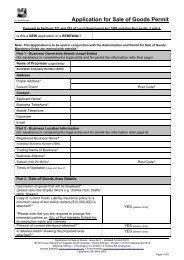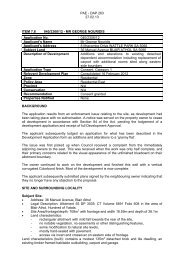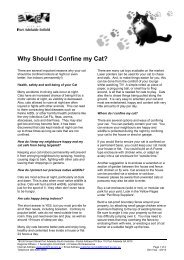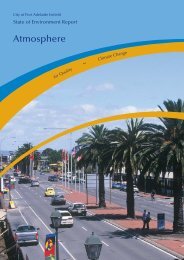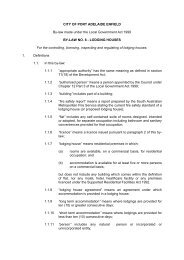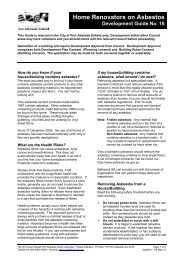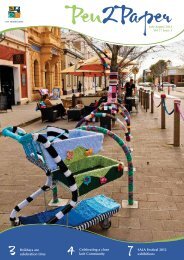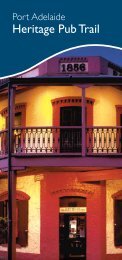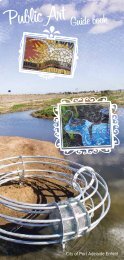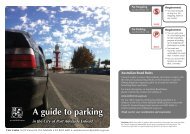Coasts & Estuaries - City of Port Adelaide Enfield - SA.Gov.au
Coasts & Estuaries - City of Port Adelaide Enfield - SA.Gov.au
Coasts & Estuaries - City of Port Adelaide Enfield - SA.Gov.au
Create successful ePaper yourself
Turn your PDF publications into a flip-book with our unique Google optimized e-Paper software.
Coast & <strong>Estuaries</strong>there were no dunes in the 1970s, and by 2001 the dune width at the jetty was approximately 100m.This occurred due to the accumulation <strong>of</strong> sand on the beach as a result <strong>of</strong> changes in wavepropagation influencing the movement and deposition <strong>of</strong> sand and further exacerbated by the loss in<strong>of</strong>fshore seagrasses (Townsend, 2005).Accumulation <strong>of</strong> sand remains significant despite at least 700,000 cubic meters <strong>of</strong> sand having beenremoved to replenish southern beaches.As a result <strong>of</strong> the young age <strong>of</strong> the dunes colonising vegetation is also recent. The dunes aredominated by introduced species such as Thynopyrum juncieform (se wheat grass) and Euphorbiaparalias (sea spurge) (Townsend, 2005).Off shore impact <strong>of</strong> <strong>Port</strong> <strong>Adelaide</strong> River DredgingAs part <strong>of</strong> the Flinders <strong>Port</strong>s development, dredging <strong>of</strong> the <strong>Port</strong> <strong>Adelaide</strong> River has been completed,resulting in the deepening <strong>of</strong> the channel by 2 metres to accommodate large ships.Land based disposal was not undertaken - the dredged soil was deposited <strong>of</strong>f shore in the Gulf StVincent. It was suggested that this activity may threaten <strong>of</strong>f-shore marine ecosystems by potentiallyspreading C<strong>au</strong>lerpa racemosa and C<strong>au</strong>lerpa taxifolia. The wider spread <strong>of</strong> this invisible alga issignificantly detrimental to seagrasses already under threat in this area. A point worthy <strong>of</strong>consideration and follow up is that the impacts <strong>of</strong> an influx <strong>of</strong> soil into the Gulf may lead to thesmothering <strong>of</strong> benthic (living on or in sediments <strong>of</strong> the sea floor) flora and f<strong>au</strong>na and increasedturbidity.Stormwater and waste water discharge to the seaLocally stormwater is discharged to the coast through the <strong>Port</strong> <strong>Adelaide</strong> River systems, as well asseveral smaller outfalls that discharge stormwater within the dunes or directly onto the beach. Thetotal estimated annual flows from the Barker Inlet system to the sea is 10.3GL (Wilkinson et al 2005 –ACWS Technical Report No.3).The Bolivar and <strong>Port</strong> <strong>Adelaide</strong> wastewater treatment plants have discharged treated effluent into GulfSt Vincent. Effluent from the <strong>Port</strong> <strong>Adelaide</strong> plant is now diverted to the Bolivar plant for treatmentrather than being discharged into the <strong>Port</strong> <strong>Adelaide</strong> River. Up until 1993, sludge from the sewagetreatment process was also discharged <strong>of</strong>fshore from the <strong>Port</strong> <strong>Adelaide</strong> plant. These dischargesincrease nutrient and sediment levels in near shore waters.In 2001/02 around 85% (or 77,329 mega litres) <strong>of</strong> this treated wastewater was discharged to the sea.Despite improvements to wastewater management and a reduction in the volume <strong>of</strong> treatedwastewater discharged in recent years, nutrient enrichment and eutrophication <strong>of</strong> marine waterscontinues. Table 31 provides more detail on the volume <strong>of</strong> treated wastewater discharged to Gulf StVincent in 2001/02.(Source: http://www.environment.sa.gov.<strong>au</strong>/coasts/adelaide_background.html#factors).159



